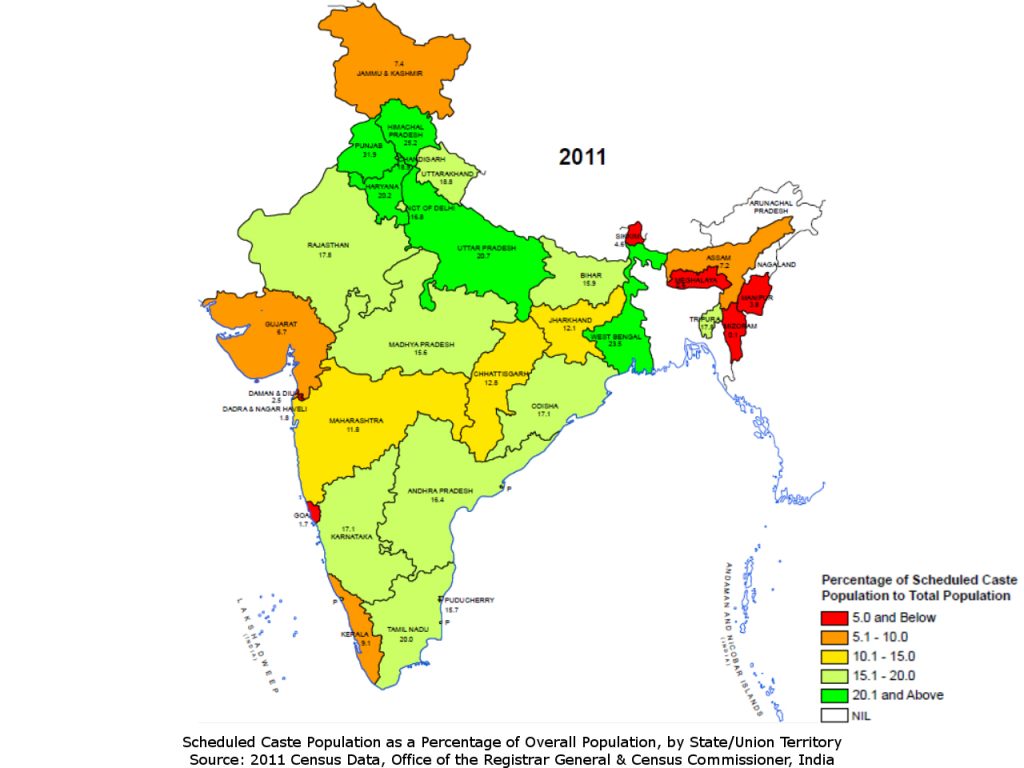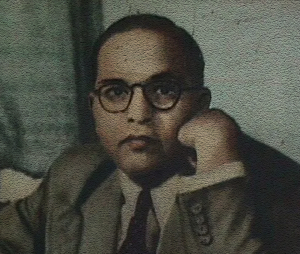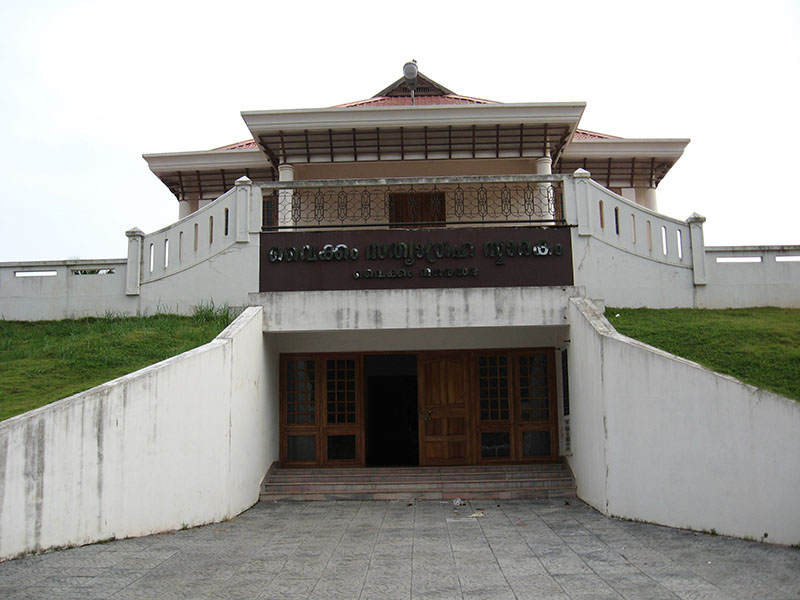By AlignIndia Editors. First Published on 05 October 2020
Featured Image: The Vaikom Satyagraha Memorial, Vaikom, Kottayam, Kerala
If there is a fundamental social, cultural and economic issue that has plagued the sub-continent over the centuries, it has to be the caste system. One would expect every political party in a 21st Century democracy to be unambiguously opposed to such a regressive and inequitable social framework. Sadly, this does not seem to be the case.

At the outset, it should be pointed out that this analysis does not focus on community demographics influencing decisions on which candidate best represents a constituency. Demographics is an inherent factor in representative democracies the world over, and one would have to be blind not to see the influence it has over candidacies globally.
The positions of the Indian National Congress (INC) and the Bharatiya Janata Party (and the erstwhile Bharatiya Jana Sangh, the BJP and the BJS) shed light on how different ideologies lead to very different attitudes towards the caste system.
Historically, the INC has been for equality in society for all castes, so much so that membership in the party entails applicants declaring that they believe in an integrated society without religious or caste distinctions, do not endorse or practise untouchability and will work actively for its elimination. It has systematically endeavoured to assimilate Dalits seamlessly in society, despite serious resistance from the Hindutva right-wing. A few efforts by the INC are listed chronologically –
- Early advocacy of Dalit upliftment: Since its founding, several distinguished INC members had raised the subject. Gopal Krishna Gokhale’s views, as expressed in Dharwad in 1903, were representative – “[I]t is absolutely monstrous that a class of human beings with bodies similar to our own, with brains that can think and with hearts that can feel, should be perpetually condemned to a low life of utter wretchedness, servitude and mental and moral degration, and that permanent barriers should be placed in their way so that it should be impossible for them ever to overcome them and improve their lot. This is deeply revolting to our sense of justice.“
- The 1917 INC Resolution: Sustained advocacy led to a formal resolution by the INC on the subject, at its 1917 Calcutta Session – “This Congress urges upon the people of India the necessity, justice and righteousness of removing all disabilities imposed by custom upon the depressed classes, the disabilities being of the most variations and oppressive character, subjecting these classes to considerable hardships and inconvenience.“
- Support to Vaikom Satyagrah: M K Gandhi fought against the social discrimination of Dalits all his life. Both he and the India National Congress extended support to the Vaikom Satyagraha, in the early 1920s. The movement was aimed at Dalits being allowed to use the roads close to a temple. In March 1925, following Gandhi’s participation in public meetings and conversations with the Travancore Regent and the temple priests, the Travancore principality gave in. This was followed by the Guruvayoor Satyagraha in 1931/32.
- Resolution for Equality: At its Karachi session in March 1931, the INC adopted the Resolution on Fundamental Rights drafted by Gandhi, which was about equality of every citizen irrespective of caste, creed or sex. It was later incorporated in the Constitution.
- The Poona Pact: Gandhi undertook a fast unto death against the implementation of the Communal Award in September 1932. Dr Ambedkar had supported the award which gave Dalits separate electorates and seats in the Constituent Assembly. Gandhiji believed this would fragment the Hindu community, segregating Dalits from other sections, while the need was to integrate all sections. After hectic negotiations, a compromise was worked out on 24 September 1932, which is known as Poona Pact. The electorate according to the pact, would be common, but the count of reserved seats went from 71 seats to 148.
- Harijan Sevak Sangh: This body was set up in 1932 by Gandhi to organize the campaign for elimination of untouchability from society. Some objected to the term ‘Harijan’ on the grounds that it meant ‘creation of God’. Gandhi was determined to eliminate the pejorative term untouchables and to create one that signified equal status to Dalits.
- Temple Entry Disabilities Removal and Removal of Civil Disabilities in Madras: These two Acts introduced by the INC government and passed in the Madras legislature, eliminated the barriers to entry by Dalits into temples in 1933 and removed all social disabilities in 1938 respectively.
- Inclusion of Dr. Ambedkar in Cabinet: Nehru inducted Dr. Ambedkar in the first post-independence government as Law minister, with the emphasis on efforts for the upliftment of Dalits. He was also made the chairman of the Constitution of India draft committee.
- Hindu Civil Code: Nehru and Dr. Ambedkar introduced the Code in 1949, amidst heavy protests by RSS/Hindu Mahasabha, who burnt effigies of both and called this a move to destroy the Hindu religion. Nehruji finally ensured that the Code was passed, although Dr. Ambedkar had died a few months before that. The Code made inter-caste marriages legal, which was a clear acknowledgement to equality of all castes in Hindu society, a revolutionary step in Indian history.
- Reservations: Accepting that Dalits were not only socially marginalised, but also economically deprived, INC introduced affirmative action through the reservation system.
- Untouchability Offences Act 1955 and Atrocities Act 1989: The INC ensured that these notable Acts were passed to codify legal action against various offences that arose from the caste of the victims.
The INC has produced several prominent national leaders who came from Dalit backgrounds, who have served as president of India, president of the INC, speakers of Lok Sabha and chief ministers in various states. Besides Dr. Ambedkar, Mr. Jagjivan Ram, Mr. KR Narayanan, GMC Balayogi and Ms. Meira Kumar are a few national leaders associated with the INC.
The Hindutva ideology of the RSS and the BJP, on the other hand, is deeply influenced by the ancient scriptures, like the Manusmriti which extensively outlines the Varna system. The system specifies a hierarchy of castes with the Dalits regarded as “Untouchables” at the lowest position. Even in the 20th and 21st centuries, with equality codified in the Constitution, the statements of many leaders of the RSS and the BJP indicate their continuing support for the perpetuation of the caste system. It would be necessary therefore to examine the Manusmriti in brief.
According to Manusmriti, society is based on a hierarchy of castes and birth decides who belongs to which caste. Some of the notable points Manusmriti makes about Dalits are:
- For the sake of the prosperity of the world, the divine one caused the Brahmana, the Kshatriya, the Vaisya, and the Sudra to proceed from his mouth, arm, thighs and feet.
- The lord prescribed to Sudras one occupation only: to serve the other three castes meekly.
- Any Sudra, a once-born man, who insults a twice-born man with gross invective shall have his tongue cut out, for he is of low origin.
- If he mentions the names and castes of the twice-born with contumely, an iron nail, ten fingers long, shall be thrust red-hot into his mouth.
- If he arrogantly teaches Brahmanas their duty, the king shall cause hot oil to be poured into his mouth and into his ears.
- With whatever limb a man of a low caste does hurt to a man of the three higher castes, that limb shall be cut off.
- A low-caste man who tries to place himself on the same seat with a man of a high caste, shall be branded on his hip and banished, or the king shall cause his buttock to be gashed.
When the Constituent Assembly of India finalized the Constitution, the RSS was unhappy. Its mouthpiece ‘Organizer’, in an editorial on 30 November 1949, complained:
“Manu’s Laws were written long before Lycurgus of Sparta or Solon of Persia. To this day his laws as enunciated in the Manusmriti excite the admiration of the world and elicit spontaneous obedience and conformity. But to our constitutional pundits that means nothing.”
Former RSS chief, MS Golwalkar wrote in his book ‘Bunch of Thoughts’- “Castes were in those ancient times too, continuing for thousands of years of our glorious national life… They serve as a great bond of social cohesion.” Further glorifying the caste system, he writes – “If the castes system had really been the root cause of our weakness, then our people should have succumbed to foreign invasion far more easily than those people who had no castes.” Golwalkar talks about samarasata (assimilation) and not samata (equality), wishing that each caste retains its identity and not be annihilated. It must be stressed that none of Golwalkar’s casteist and communal writings have ever been denied or denounced by the RSS or BJP. They wholeheartedly support the caste system.
Even Narendra Modi wrote that Dalit manual scavengers feel spiritual pleasure in doing their work. Similarly, his cabinet colleague, VK Singh tried to downplay the accountability of the government for an incident in which two Dalit children were burnt alive by comparing it to the stoning of dogs.
Here are a few instances that illustrate how the RSS and the Sangh Parivar in general demonstrate their contempt for Dalits. In Dulena, Haryana in October 2002, five Dalits, with a government license to do so, were skinning a dead cow, when Vishwa Hindu Parishad members lynched them. Instead of condemning this gruesome murder, a senior leader of the VHP/RSS, Giriraj Kishor justified the lynching, claiming that the life of a cow was more important than the lives of any number of people. The RSS/BJP maintained a deafening silence about the crime by their associates.
In July 2016, in Una, Gujarat, four Dalits were brutally beaten up by cow protection group workers, usually affiliated to the Bajrang Dal, RSS, VHP or BJP, in the name of cow protection in presence of hundreds of people around. Similarly, in October 2015, in Faridabad of BJP ruled Haryana, two children of a Dalit family were burnt alive by upper castes, the mother and father sustaining severe burn injuries.
The RSS has had no Dalit in the national body of their organisation, let alone a Dalit chief. The RSS/BJP dare not openly practise untouchability, a serious breach of the Constitution of India. They are opposed however to any reformation that strengthens the Dalits – be it in the Constitution, the law or in the reservation system. Their position has not altered much from that of B S Moonje, the mentor of RSS founder Dr. Hedgewar, who said “Any money spent on untouchables is like feeding a garden-serpent with milk.”

Dr. Ambedkar was critical of the Hindutva ideology with Manusmriti as its code. “At the root of the Hindu social system lies Dharma as prescribed in Manusmriti.” he wrote. “Such being the case, I do not think it possible to abolish inequality in the Hindu society unless the existing foundation of the Smriti religion is removed and a better one laid in its place.” He was of the firm opinion that Hindutva was nothing but a ploy by upper caste Hindus to maintain control over society and its resources. He wrote, “They have a monopoly of education and wealth, and with wealth and education they have captured the State. To keep this monopoly to themselves has been the ambition and goal of their life.” About Manusmriti, Dr. Ambedkar wrote – “There cannot be more degrading system of social organization than the Chaturvarna. It is the system which deadens, paralyses and cripples the people from helpful activity.” He symbolically burnt a copy of the Manusmriti on “Manusmriti Dahan Din”, 25 December 1927.
According to Dr. Ambedkar, the attitude of Hindutva towards minorities is the same as with Dalits. He wrote – “The attitude of keeping education, wealth and power as a close preserve for themselves and refusing to share it, which the high caste Hindus have developed in their relation with the lower classes of Hindus, is sought to be extended by them to the Muslims. They want to exclude the Muslims from place and power, as they have done to the lower class Hindus. This trait of the high caste Hindus is the key to the understanding of their politics.”
Dr. Ambedkar’s strong antipathy towards Hindutva has not prevented current day RSS/BJP from attempting to appropriate him. Dr. Ambedkar spent a lifetime in a crusade against the oppressive Hindutva that RSS/BJP practise. He even renounced Hinudism and converted to Buddhism. The RSS/BJP’s attempt is just as ludicrous as their efforts to somehow associate themselves with Bhagat Singh and Congress leaders like Sardar Vallabhbhai Patel and Subhash Chandra Bose.
All of this stems from two distinct goals – one is their objective of belittling Gandhi and Nehru who are iconic in Indian history and the other is the lack of any Sangh Parivar figure who played a significant role in the Indian freedom movement. While the INC has always fought against oppression and the exclusion of Dalits from society and politics, RSS/BJP has been trying to keep them exactly where they were for centuries: excluded and exploited. The diagonally opposite attitudes of the INC and the RSS/BJP originate in their starkly differing ideologies. For the INC, social justice, inclusion and secularism are at the heart of its ideology, while Hindutva and Varna system as enunciated in Manusmriti are the ideology of RSS/BJP. To fight the curse of exploitation and exclusion, we must reject the RSS/BJP ideology in modern Indian society, culture and politics.
(AlignIndia helps you dismantle propaganda piece-by-piece, so that Indian Democracy stays alive. The deafening din of bigotry and jingoism has made us forget Gandhi, Nehru, Patel, Shastri and scores of other leaders who built India based on the values of peace and ethics, standing up for the downtrodden and the voiceless. Our effort is aimed at reviving these core values as enshrined in the Constitution of India while fiercely protecting the diversity, which defines the idea of India.)


